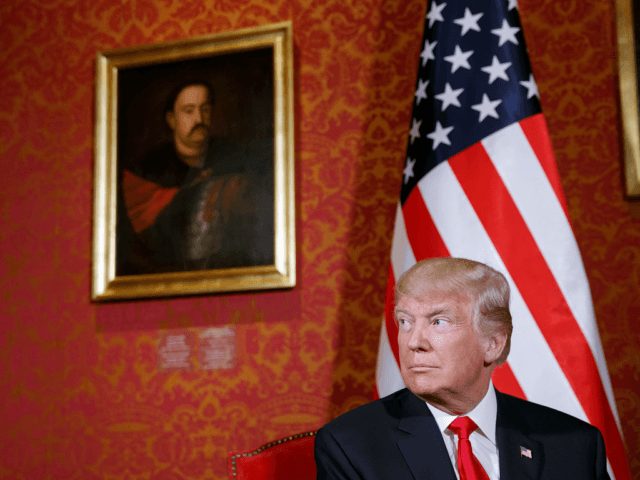I love the Polish people more each day.
They are quickly becoming one of our best allies in the world. Huge crowds gathered to cheer on President Trump when he first arrived in their county. In the middle of the night, but who’s counting!
Then this happened. President Trump was seated very intentionally under this image of historic Polish King Jan (John) III Sobieski. Ok, you might ask, what’s the big deal? Well, King Sobieski is famous in history for kicking Islam out of Europe! So famous, in fact, he was nicknamed “the Hammer of the Turks”.
Sounds like my kind of guy!
And Poland must have thought he sounded a lot like our President Trump too, because they very intentionally seated our President under his portrait. I love it! Now that’s an honor I’m sure President Trump is proud to receive!

Here’s more, from Breitbart:
President Donald Trump’s first photo-call in Poland after his arrival in Air Force One was with President Andrzej Duda and saw him sat beside an oil painting of a prominent figure in Polish history and folklore — the 17th-century king who kicked Islam out of Central Europe and is remembered as “the Hammer of the Turks”.
Warsaw’s Royal Palace, where the meeting took place — lavishly reconstructed after it was dynamited by Nazi German troops during the Second World War — benefits from a surfeit of grand rooms and hundreds of works of art.
From oils of kings and statesmen by artists such as Rembrandt to impressive murals and sculpture, the Polish authorities had a great deal of choice for where to host the symbolic first meeting of President Trump’s first European visit.
It may be seen as a remarkable coincidence, therefore, that of all the rooms and of all the paintings, they chose to sit President Trump besides a portrait of one of Poland’s best-known warrior kings. King Jan (John) III Sobieski is today remembered and celebrated in Poland, and elsewhere in Central Europe, for his pivotal role at the Battle of Vienna in September 1683.
At the culmination of the two-month siege of Vienna by the forces of the Ottoman Turkish Empire, Sobieski led an army to relieve the city. Despite leading a force significantly smaller than the invading Ottomans, the coalition of Polish and Germanic troops staged one of, if not the largest, cavalry charge in the history of warfare and defeated the Ottoman army — ending centuries of Islamic attacks and invasions reaching the heart of Europe.
In today’s Poland, concern over the place of Islam in Europe continues — and the nation’s strong opposition to mass migration from non-Europeans has caused enduring friction with leaders in Brussels and Berlin, who are fully dedicated to open borders.
In a poll taken to coincide with Trump’s arrival in the country, when asked whether they would be willing to forego European Union money if it meant being able to continue blocking migrants from outside Europe, the majority said they would rather maintain their culture and nation and forego the cash.
The news may come as a blow for planners in the European Union, who have recently threatened to turn off the tap of development funds — of which Poland is the largest recipient — if they do not agree to open their borders.
Anglo-Polish expert on royalty and European history Rafe Heydel-Mankoo spoke to Breitbart London and said of the juxtaposition of King and president: “Having routed the Ottomans and saved Christendom, King Jan III Sobieski took the captured green standard of the Prophet and sent it to the Pope, along with the words “Veni, Vidi, Deus Vicit” (I came, I saw, God conquered).






Join the conversation!
Please share your thoughts about this article below. We value your opinions, and would love to see you add to the discussion!